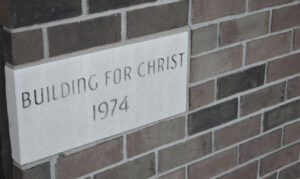Our History

Our Heritage
The Christian Church began as part of the “Disciples of Christ” denomination nearly 200 years ago and is one of the largest churches founded on American soil. Frontier America was searching for a faith based on Christian unity, individual and congregational freedom, and restoration of a simple New Testament Gospel. The Christian Church (Disciples of Christ) was born of this search. However, in recent years the leaders of the denomination, Disciples of Christ, have veered away from biblical teaching. Because of that, Central Christian church with much consideration decided to become a non-denominational worship center.
Born in Ireland, Presbyterian minister, Thomas Campbell, moved to America in 1807. He broke with all denominational ties with a wish to unite all Christians upon the Bible as the only authoritative rule of faith and practice. His fundamental principal was “Where the Scriptures speak, we speak; where the Scriptures are silent, we are silent.” In 1820, Thomas’ son, Alexander, having devoted himself wholly to the Lord and holding to the same beliefs and principles as his father, began public debates which propelled him into leadership of the “Disciples of Christ”. He was known as one of the greatest preachers of the time, using the Scriptures as the sole standard of faith and work.
Presbyterian Minister Barton Stone from Kentucky and several followers broke their denominational ties, and in 1804, took the Bible as their sole rule of faith. In 1832, Stone and Campbell’s congregations joined. Alexander Campbell became the foremost leader in the new movement known as Christian Church (Disciples of Christ).
The Building
Ebenezer Thompson II was a successful farmer in Braken County, Kentucky and acquired some wealth. He was a devout Christian, preaching quite often. He was one of five men to whom an acre of ground was given to start the Christian Disciples Church and Maple Grove Cemetery in Kentucky. Ebenezer became a follower of the teachings of Thomas and Alexander Campbell and Barton W. Stone. In 1837, 1839, moved to the state of Indiana.
Ebenezer and Mary Ann Thompson, along with 13 other early settlers in Huntington, met in the Thompson home on Riverside Drive at Broadway on April 14, 1845. From that early meeting, the First Christian Church in Huntington had its beginning. Mr. Thompson was a lay preacher who ran a saw and flour mill. The group met in the Thompson home for six years carrying long planks into the house to place on chairs in order to seat the worshipers. When the congregation grew too large for the home, they met in the court house. Baptisms were conducted in the river. The first church was erected in 1851 on the corner of Franklin and Guilford on a lot that had been purchased for $1.96 for tax delinquency by C.P. Bagley who was the son-in-law of Ebenezer Thompson. He then gave the lot to the church.
When the frame church was outgrown, it was replaced by a brick structure in 1881. In 1898 the church was remodeled at a cost of $7000.00 adding a new section with more Sunday school rooms. Granddaughter of Ebenezer Thompson, Mrs. BHB Grayston played the organ at the dedication.
In 1905 the congregation again outgrew its facility and, this time, hired nationally known architect George W. Kramer. The new building was dedicated in 1906 with Mrs. Grayston again playing the organ for the dedication. It was about this time that the name was officially changed to Central Christian Church. By the end of 1962, the basement was remodeled and turned into “Fellowship Hall”.
In 1959 the membership once again realized a need for a change in facilities. The need was for a building with ample parking and handicap accessibility in order to continue to expand in program for religious growth and activities. Ground was broken May 6, 1973 on the current site, 500 MacGahan Street. The formal dedication took place the Sunday before Thanksgiving on November 24, 1974 followed by a reception, open house and concert.
Ground was broken once again in June 2, 1996 for the edition now known as the Family Life Center with additional new classrooms and office complex. This project was completed and then dedicated October 19, 1997.
The Organ
Music has always played a very important part of our worship celebrations. The significance of music and musical instruments is attested to in many biblical references, especially in the book of Psalms. We kept this tradition alive with the help of the beautiful C.B. Fisk pipe organ dedicated October 3, 1976. The craftsmanship of this beautiful organ has been acclaimed by renowned organists around the world. In addition to being an instrument of visual beauty, the Fisk organ is most of all an instrument of praise. Through it, we hope to be uplifted to an exciting and moving sense of the presence of God, to the end that we might glorify God. We dedicate this instrument of praise. Recently, we have added a Praise Band and Worship Team to enhance the worship service and add the many beautiful contemporary songs and music of the day.
Our Symbol
With a strong emphasis on the Lord’s Supper, the Disciples have chosen the red chalice, representative of the cup filled with the blood of Christ. The white X-shaped cross of St. Andrew on the challis symbolizes the strong Scottish Presbyterian root out of which the Disciples emerged. The Lord’s Supper, or Communion, is celebrated weekly and is open to all believers. With the new non-denominational status we have chosen a new symbol for our church family. While we still hold Communion as a focus point of our service and continue to celebrate it every week, our new church symbol bears the cross of Christ and the Christian Fish.
Baptism
Baptism is a central belief and practice of the Christian Church Disciples of Christ. It is the foundational act on which the life of Discipleship to Jesus Christ is built. It is symbolic, scriptural, personal, and corporate. It symbolically recalls the death, burial, and resurrection of Jesus while at the same time acts out the death and burial of the old self of the repentant believer and the rising to new life “in Christ.”
Disciples baptize by immersion for two reasons. First, baptism by immersion follows the witness of the scriptures concerning Jesus’ own baptism by John in the Jordan (Matthew 3:13-17; Mark 1:9-11; Luke 3:21-22) and the practice of the early church. (Acts 8:38-39; 18:8)
Second, most Disciples believe that baptism by immersion best symbolizes the death, burial, and resurrection, the story of salvation.
Most Disciples today recognize other forms of baptism as valid but choose for themselves baptism by immersion.
